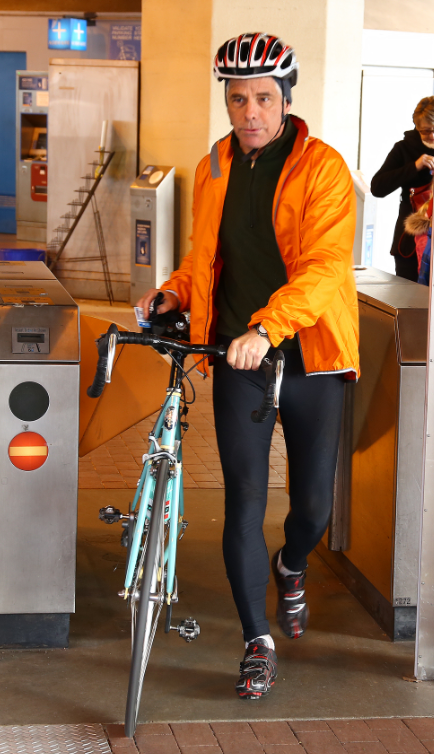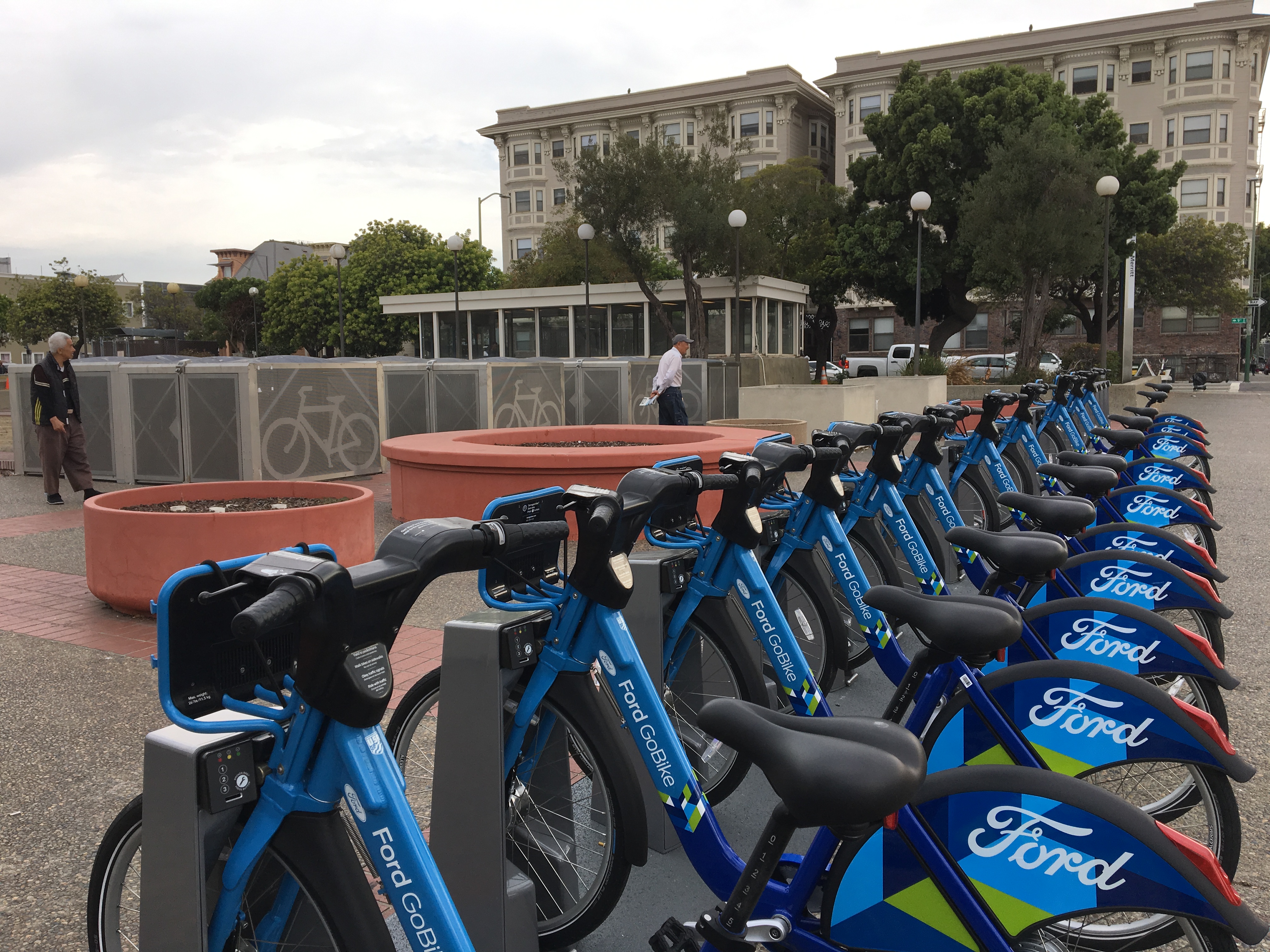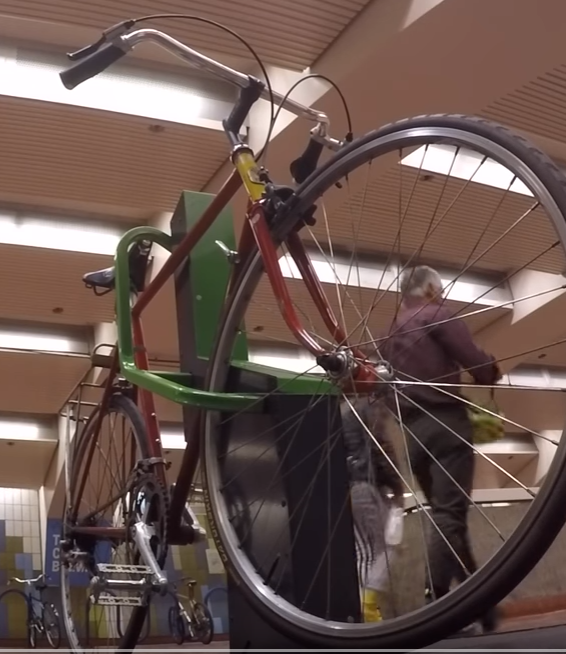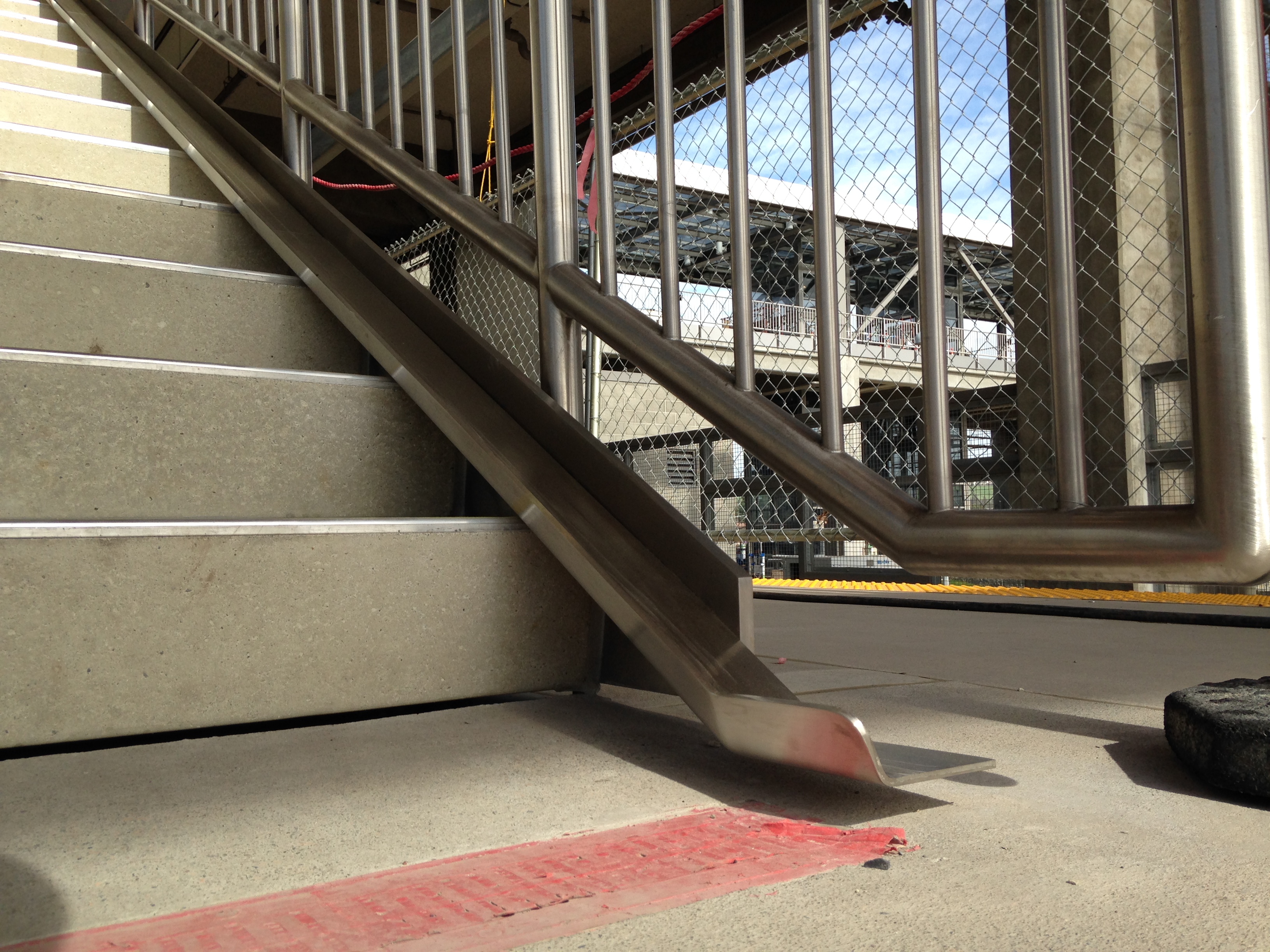BART has a plan for expected surge in bike usage
Several exciting initiatives are underway to make BART even more accessible for bicyclists. In the latest edition of “Hidden Tracks: Stories from BART,” we’ll hear from BART Bicycle Program Manager Steve Beroldo. From a big expansion in the Ford GoBike bike share program to new high-tech ways to secure your bicycle there are many bike-friendly ideas that are being turned into realities at BART. Beroldo shares his thoughts about the various programs as well as what he says is a growing trend in the number of people who use their bikes to get to BART.
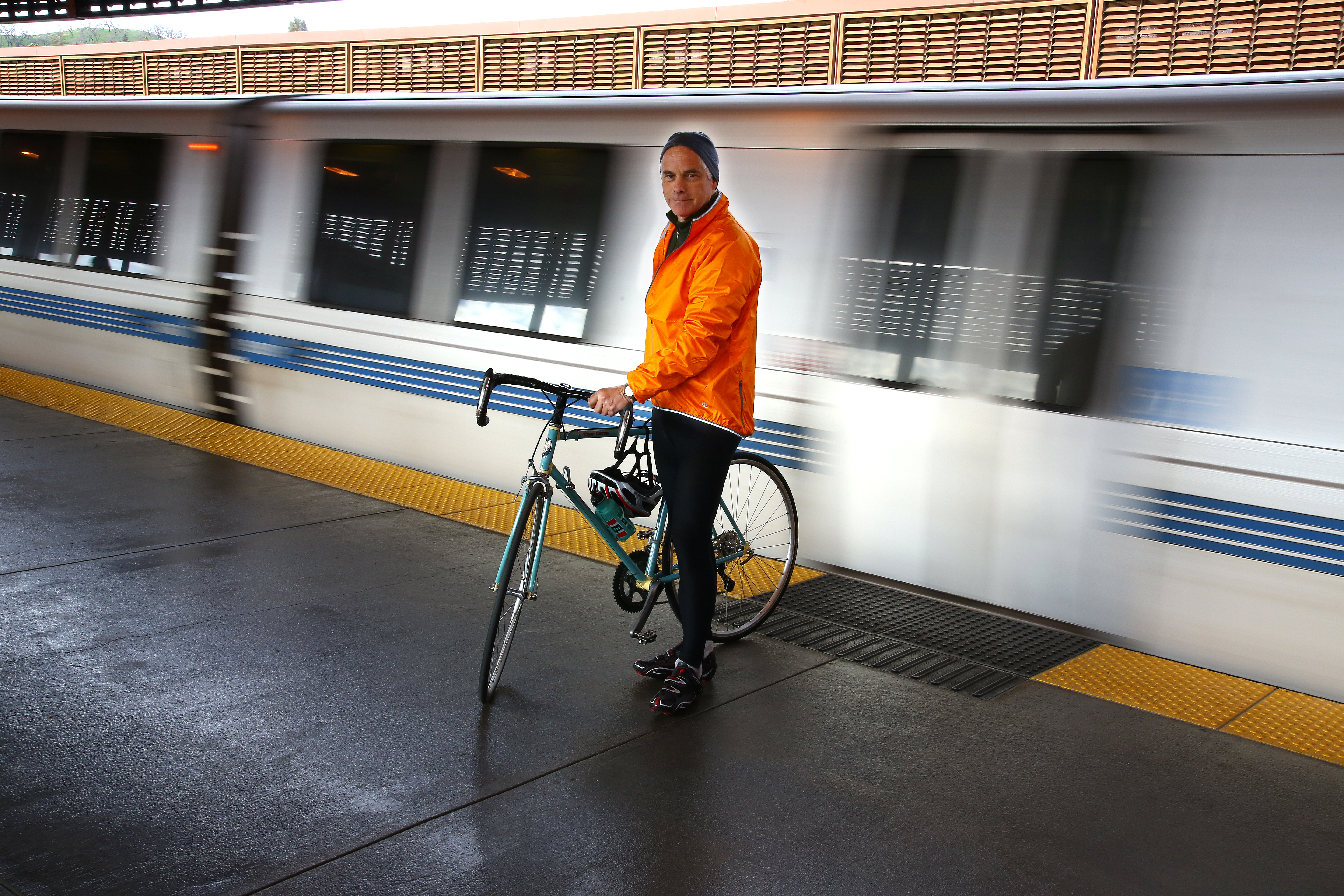
BART Bicycle Program Manager Steve Beroldo
Transcript below:
HOST: “More and more people are riding their bikes to BART and the agency has a plan to meet that growing demand. Welcome to “Hidden Tracks: Stories from BART.” On this latest edition of Hidden Tracks I’m speaking with BART Bicycle Program Manager Steve Beroldo who says in just a few years more than 20,000 people a day could be riding their bikes from home to BART. Steve, thanks for joining us.”
BEROLDO: “My pleasure, glad to do this.”
HOST: “BART’s been on this mission to double the rate at which riders access the system by bicycle. Can you put that into perspective for us? Give us an idea, how many riders do we currently estimate ride their bikes to BART?”
BEROLDO: “Back in 2012 we developed a strategic plan that laid out some strategies for improving bike access to BART and along with that we created a goal. We were at about 4% bike access at that point and we said ‘let’s double that by 2022’, 10 years forward from the date we were working on the plan. We’ve been making some good progress we’re at about 6% bike access now, a little more than halfway through that time period and hope to keep growing bike access by both marketing biking, by providing good parking options for people, by letting people bring their bikes on the train, and for just making it a more attractive way to get to BART.”
HOST: “Are you hearing from a lot of folks that they’re interested in this? It sounds like the trends are in an upward direction here.”
BERALDO: “The trends are definitely in an upward direction. I think a lot of it are the demographics of the Bay Area. I think there’s a lot of people who are creating a lifestyle where they don’t necessarily need to own a car anymore. There’s lots of options to get around as well a know from Uber and Lyft quick-ride to using your bicycle to walking more to living closer to the things that you need including BART stations. As BART matures and we have more riders we’re not really creating a lot more vehicle parking so I think one of the options for folks, especially if you maybe live a little further than it’s comfortable to walk, is to jump on your bike and ride a couple of miles to BART. It can be quick, it could be simple, it could be healthy and I do it, I think it’s fun.”
HOST: “Yeah I was just going to say you live the life, you’re an example of that and I think that’s kind of important that you know what the experience is like for our riders so you can appreciate what some of the things are that they might be looking for.”
BERLADO: “I jumped into this job after doing some other things here at BART about seven years and part of what captured my interest is I’ve always used my bike just for daily trips to get around as well as recreation riding. I just thought there was a lot that could be done at BART to improve and encourage bike access and I could see, as I was mentioning earlier, with some of the other challenges in terms of getting to BART and driving a car, limited bus access maybe that bikes had a lot of potential.”
HOST: “You must have a lot of experience riding bike trails that are BARTable. Share that with our folks, there must be a lot of interesting options out there.”
BEROLDO: “That’s a great segue because I really dislike putting my bike in car to get anywhere. But putting my bike on BART and getting me out to Walnut Creek or to someplace where I can get to trails that I can’t normally get to from my home in Berkeley is a great way to find new rides and to go to new places without having to use a car with my bike. A couple of my favorites, one is the Bay Bridge Trail, which is easily accessible from MacArthur or West Oakland Stations. It’s a great ride, eight miles across the bridge on to Treasure Island, do a nice loop on Treasure Island and then come back to the East Bay. Going out to Walnut Creek or Pleasant Hill easy way to climb Mt. Diablo if you’re into a little bit more difficult ride but both of those have nice access to the mountain there.”
HOST: “One of the really interesting things gaining momentum now is the Ford GoBike bike share program. What is that and how does it involve BART?”
BEROLDO: “The bike share program is not totally new to the Bay Area but it’s probably the most exciting thing happening right now. We’ve had a demonstration project here for a few years operated by the Air District with about 700 bikes in San Francisco. A couple years ago a Brooklyn-based company called Motivate that operates a lot of the bike share programs around the country approached MTC and said, ‘hey, we’d like to roll out a much bigger program here in the Bay Area and we’ll basically do it for free, no public money involved, as long as we have sort of exclusive rights to the sponsorships and advertising associated with it.’ So right now there’s about 7,000 bikes being rolled out in San Francisco and in the East Bay. The old program was only in San Francisco, the new one includes Oakland, Berkeley, and Emeryville. For BART it’s great, we’re going to have docks of bikes at all of our stations from North Berkeley all the way to Fruitvale in the East Bay and from Balboa all the way through Embarcadero in San Francisco. For our passengers, it basically means that BART goes more places. You might have been able to get off BART and comfortably walk a mile or so but now you can get off BART, jump on a bike share and maybe go two or three miles easily. It’s a great program. Most of the region looks at it as an extension of the transit system and we’re really excited to have the bikes right at our stations.”
HOST: “You look at it and that sounds like a really big number, 7,000 bikes. Do you anticipate that sort of demand for this?”
BEROLDO: “It’s a huge number and it’s going to be one of the biggest bike share programs in the country and I think it says a lot for the culture here in the Bay Area that the folks who are rolling this program out and investing it really feel like it’s going to take off and be popular. Frankly the bike share programs work best sort of based on a critical mass. The more bikes you have, the more docks you have, the more useful the program is. It’s kind of a self-fulfilling prophecy; build a big bike share program and it’s likely to be successful.”
HOST: “Do you think this program could have any impact on the number of bikes that are on our trains?”
BERLODO: “Sure, that’s one of the things we’re really hoping happens is that folks who might now take their bike because they want it on their destination end will say, ‘hey, it’s a lot easier for me just to park my bike at my home station and then when I get into San Francisco or into Berkeley jump on a bike share bike and finish the last mile or two of my trip to their destination.”
HOST: “And this is not something that’s way far off, this is happening right now.”
BEROLDO: “The bikes are being rolled out right now. We have them near most of our downtown San Francisco stations. We recently installed them at MacArthur, Ashby, and Lake Merritt in the East Bay. Just out with folks yesterday as 24th Street finding a location there so they’re rolling out now I’d say in the next six months that these bikes are going to be at all of our stations in the Oakland, Berkeley, San Francisco area.”
HOST: “There’s a lot going on in the system and I know a lot of it relies on technology and finding ways to safeguard bicycles, that’s a concern for everybody certainly. Tell me about the pilot program that started at the 16th Street/Mission Station and now is even being tried at Pleasant Hill.”
BEROLDO: “We’re always looking for more secure ways for folks to leave their bikes at BART. We have a series of bike stations where people actually have valet bike parking. We have self-serve sort of key access bike parking, we have on-demand bike lockers, and the newest thing we’re experimenting with is a high-security smart rack made by a company called Bikeep. They’re a European company and they’ve had a lot of success deploying these in Europe and they’re just moving in the U.S. We’re the first public agency to give these a try. We installed a set at 16th Street a month or so ago, another set is about to open at Pleasant Hill in the next week and then we’re going to do an installation at Hayward also. It’s a nice system, we’ve actually set it up so folks can use their Clipper card as their key essentially to open and close the racks making it really simple. The track record is really amazing. There’s yet to be a bike stolen from one of the Bikeep racks. So we want to kick the tires, we want to put some out there, make sure they function well for us, get some feedback from the folks who are using them see how they like them. I see it as a nice product that can fit and serve some of the needs that some of the other secure parking options aren’t really set up for. So I think it’s going to be a good, I’ll use the word weapon in our arsenal of secure bike parking going forward.”
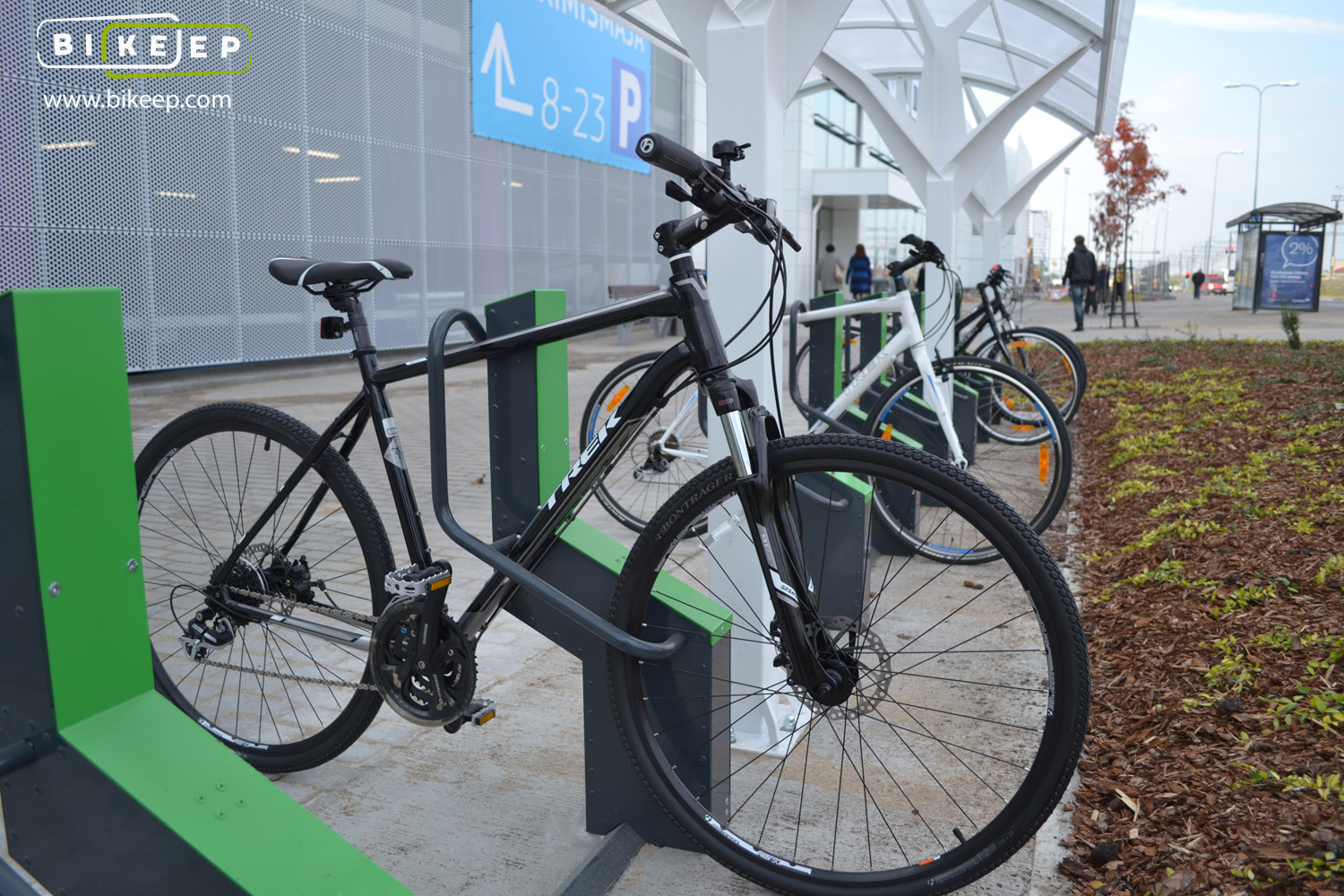
HOST: “Technology is really so critical here because it seems like those that want to take the bikes away are always using new methods to accomplish that. But this technology you said so far has been highly effective.”
BEROLDO: “The actual locking mechanism is a high-strength steel bar that kind of hinges up and grabs the bike in two spots. It grabs the front wheel and the frame. Very hard to cut through. It actually has an alarm inside the tubing and if someone tries to cut through the tubing it will trigger an alarm. Thefts often occur with the lowest hanging fruit. People who leave bikes locked less than securely are most likely what folks are going to go after first. The Bikeep racks I think are at the very higher end of that food chain and they provide a pretty secure option.
HOST: “I’m speaking with Steve Beroldo who is the bicycle program manager here at BART. Steve, BART also offers about 1,500 BikeLink eLockers at 37 stations. How do those work and what’s been the response to those?”
BEROLDO: “The BikeLink lockers are extremely popular. It allows you to not even have to carry a lock with you. You can leave your accessories on your bike because you’re basically in your own single space locker. We use an operating system called BikeLink, it’s essentially a little debit/ID card. We charge five cents an hour for use of the lockers. We do have them at every East Bay station and all of the stations from Glen Park west in San Francisco. They provide a nice, secure option and they provide some real benefits in terms of weather protection and being able to leave your gear with your bike.”
HOST: “It seems like these different ideas like there isn’t one catchall solution. It’s a variety of ideas. Different ideas, I would assume, work better at some locations than others. But overall it seems like it’s having an impact in terms of driving down the number of bike thefts that are occurring in the BART system. Is that the case, are we seeing a downward trend there?”
BEROLDO: “The trend of reported thefts is definitely downward. In addition to providing the more secure options, the bike stations, the Bikeep racks, the bike lockers we’ve also had a pretty robust educational program. I guess the biggest problem going back has been people using sort of low security cable locks on their bikes. When somebody rides a bike to BART they often leave it for 10 hours. They’re off to work for the day, they have their commute time, their lunch break, it’s there for a long time. We’ve done a lot of education getting people to use U-locks and good quality U-locks on their bikes rather than cable locks and I think that’s helped a lot.”
HOST: “Now we’re sitting in Steve’s office and in the corner there’s a cardboard box and it is full with all sorts of bike locks that look like they’ve been defeated by someone. Describe what I’m looking at over here.”
BEROLDO: “I grab them when I’m out and about. I see them lying around and it’s always interesting to see how people do defeat locks. Some of them are pencil-thin cable locks, which literally you could cut through with scissors and that’s really what we’re trying to discourage folks from using. Unfortunately, in that box are some U-locks too, they’re not undefeatable. There’s plenty of tools and plenty of energy out there to steal bikes. We do our best to coach people to use two good quality U-locks on their bikes and those bikes are pretty secure. Even U-locks come in different qualities and it is easier to defeat some of them than others. For your question earlier, we do try to provide a range of parking options because some people really what they want to do is ride their bike and lock it on a rack. They’re not interested in getting a BikeLink card and using a locker or figuring out some of the other options. So we do provide plenty of racks. We try to put them in really high visibility locations. We actually have quite a few of them now in the paid area of BART stations within the line of sight of our Station Agents. And the combination of some people wanting a rack, some people wanting a locker, some people going out of their way to use our bike stations. I think it’s a good blend and hopefully we’re providing stuff for everybody’s taste.”
HOST: “And speaking of bike stations, we’re seeing more of those in the BART system, it seems like especially in the East Bay. It seems like there’s a lot of interest in those.”
BEROLDO: “The bike stations are something we’re going to be investing in pretty heavily going forward for the next few years. We’re about to open our 8th one at Pleasant Hill. It’s going to have a keycard access bike parking area, which you can do 24/7. It’s also going to have a retail maintenance facility to support folks in their maintenance needs and picking up a lock and stuff, which we have at a couple of other facilities right now also. We just completed a plan with intentions to build nine additional bike stations around the district, mostly in the East Bay.”
HOST: “BART has a really heavy emphasis on transit oriented development; the idea that it makes sense for folks to live close to public transit. It’s better for the environment, better for everybody, better for traffic. How does that influence, that TOD influence, come into play when it comes to our policies for bikes.”
BEROLDO: “If a TOD is situated close enough to a BART station obviously folks can walk to the station. The project at Pleasant Hill is an interesting one because the bike station there is integrated with the TOD project. We’re actually utilizing a space built by the developer there at Avalon Bay. We’re doing our own sort of tenant improvements creating both the retail maintenance facility and the bike parking but at that project and several others going forward were going to try to integrate bike station parking into the TOD developments.”
HOST: “Of course some riders when it comes to taking their bikes to BART they can’t just park them at a station they want to take it with them onto the train and I know BART is looking at different ideas to facilitate that. One of those ideas is a stair channel. What is that and where are they being used?”
BEROLDO: “A stair channel is essentially a mini ramp along the edge of a stairway that allows cyclists to roll their bikes up and down stairways rather than having to carry them. We have a nice model we developed and built at our 16th Street Station. We have them at a couple of other stations, at the new Warm Springs Station we have the bicycle stair channels. We’ve been developing a standard design, which is the way BART moves forwards with projects and we have intention to use these stair channels almost as a carrot approach to guide bikes through our stations and the routes that have the least conflict with pedestrians. With some signage and the stair channels we feel we can get folks to use our wider, less heavily used stairways to keep bikes off escalators. We do not allow bikes on escalators although unfortunately it’s a pretty common occurrence. Our elevators are limited and not always the best option for cyclists so we feel like the stair channels can help folks to transport their bikes vertically within our stations.”
HOST: “I’m speaking with BART’s bicycle program manager Steve Beroldo. It really is a balancing act isn’t it? The bikes can be kind of cumbersome, especially on the system. I’m thinking morning and afternoon commute there are so many passengers in the system already that space really is at a scarcity. What sort of advice do you have for folks who want to take a bike on the system?”
BEROLDO: “A couple years ago our board being very forward thinking relaxed BART’s restrictions on taking bikes onto the trains during the commute period and for the last few years we have allowed bikes at all times on all trains with one important rule basically and that is if the train is too crowded don’t board it with your bike. It’s something that requires folks to kind of make a judgement call when they see a train. Now all of our trains currently have two spaces, one at each door, set aside for bikes. There’s an area that’s signed for bikes and there’s a bar to kind of lean your bike against. We’re actually testing some straps right now that will help people hold their bikes in place. But the trains are crowded and as we were saying earlier there are more and more folks taking their bikes on BART. What I have noticed, and it’s really heartening to see, when we first changed the rules people were used to getting on and maybe one person would use the bike space and other people would kind of stand in the middle of the train with their bikes. But people have really learned that they can just lean their bikes together all in the bike space and it’s become a pretty efficient way to carry bikes on the trains.”
HOST: “In line with that here’s a question I think a lot of our riders have and especially folks who take their bicycles on the system. Why do we not allow bicycles on the first car of a train?”
BEROLDO: “That rule goes way back and it has to do with in an emergency situation there’s some equipment that the train operator may need to get to. The train operator also may need to get out of the first car quickly and the feeling is that bikes could provide some interference or interfere with the safe operation of the train. It’s a safety-related rule and I think it’s a pretty minor rule in terms of most trains have ten cars so there are nine others for bikes. It also provides a place for folks who really don’t want to deal with bikes they know if they get in the first there won’t be any on it.”
HOST: “The regulation of bikes on BART has kind of been an evolution over time. It’s almost hard to imagine that there was actually a point where if you wanted to take your bike on to the system you had to register and you had to get a card from BART essentially to have permission to do that. I mean that just seems really strange compared with where things are right now.”
BEROLDO: “And that’s actually an improvement over where BART started. When the system first opened there were no bikes allowed period on the trains. There was some advocacy work by bike groups and BART relented and started allowing people on with a permit. You had to ride in just the last car of the train and it is pretty exciting that now, 40 years later, we basically allowed bikes on all cars at all times. In between there were periods where there were commute period restrictions and certain stations you couldn’t go into at specific hours and no bikes on a number of cars. But at the moment we’re allowing bikes on all cars at all times with a few restrictions but it seems to be working great.”
HOST: “You see a lot of cities adopting more bike lanes in their communities; even smaller cities are really starting to add those bike lanes. Do you feel like in the Bay Area we’ve kind of had this awakening, especially in recent years, that bikes are an important part of our community and a way to get around that potentially takes a car off the roadways.”
BEROLDO: “I think the progress that a lot of cities have made in the last few years is huge and I think people think of sustainability and that driving and building big parking lots is really not the best solution for the long term. As we’ve seen from some European cities where bikes are the primary way of getting around pretty much if you build it they will come. I think the cities who are investing in bike infrastructure and bike lanes, the most recent movement is trying to create bike infrastructure where everyone is comfortable. Not just the real serious bicyclists but where kids and seniors and everybody can feel comfortable and safe riding on their streets and I think that’s going to dramatically expand how many people use their bikes and how many places we can get to on them.”
HOST: “You look at it and you actually mentioned it earlier that people are learning how to place their bikes properly on the system and a big part of that also is those bike straps that are being experimented with and being added to more and more trains. It seems like a pretty cost effective option and it seems like there’s been a lot of positive response to that. What have you heard?”
BEROLDO: “We have them, we have about 60 sets being tested on 30 different cars right now and the feedback has been extremely positive. Basically, the main comment we see is put more of them out there we really like them. Folks have been very creative, they’ll use their helmet or take a bungee cord with them or figure out some way to kind of wedge their bike so it stays in place. But having the straps, we’re testing two versions one has a buckle and one has Velcro. They’re nice strong material, kind of like a seatbelt material. I’m pretty certain will be making some minor tweaks to them and then rolling them out on all the cars in the near term. They are as use said a very cost effective, they actually improve safety. It’s nice that a bike strapped into place isn’t going to accidentally roll and bump into someone so it’s one of those things that I think is a win-win product.”
HOST: “There’s so much excitement about the Fleet of the Future. The first cars are going to come on later this year and they’re going to be some really big changes when it comes to bikes and how bikes are going to be able to be stored on the new cars. As I understand they include bike racks, which is a big change for BART.”
BEROLDO: “They’re similar to bike racks, I like to refer to them as a bike-holding mechanism. It’s essentially like a spring-loaded clamp that you push your wheel, either your front or rear wheel in to. So there will be a bike space very similar to the spaces that we have on our current older fleet but this will have a basically a bike rack, bike holding mechanism to keep bikes in place.”
HOST: “Any other changes on the Fleet of the Future that would impact bike riders?”
BEROLDO: “I think the three doors are going to be helpful. Right now if a bike is, the area around doors can get crowded, so I think with three doors it’ll be easier for folks to get in and out and the bikes will hopefully be less in the way.”
HOST: “Steve Beroldo, bicycle program manager for BART thank you so much for speaking with us.”
BEROLDO: “My pleasure.”
HOST: “And thank you for listening to “Hidden Tracks: Stories from BART.’ You can listen to our podcasts on SoundCloud, iTunes, Google Play, Stitcher and of course at our website at BART.gov/podcasts.”
